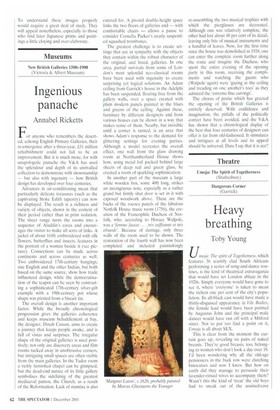The Dawn of the Floating World (Royal Academy, till 17 February 2002)
Rosy view
Martin Gayford
Living only for the moment, turning our full attention to the pleasures of the moon, the snow, the cherry blossoms, and the maples, singing songs, drinking wine, and diverting ourselves just in floating, floating, caring not a whit for the poverty staring us in the face, refusing to he disheartened, like a gourd floating along with the river current.' Apart from the references to cherry blossom and the moon, I suppose that could be a resume of many a barfly's attitude to life. In fact, it is a passage from the preface of a novel published around 1665 by a Japanese writer, Asai Ryoi. It is celebrated as one of the first and best accounts of the ethos of the 'floating world', or as it is known in Japanese. ukiyo. The early history of this way of life and the art associated with it is the subject of this fine and scholarly new exhibition in the Sackler Galleries.
Geographically, the floating world was moored principally at Yoshiwara, the government-licensed brothel quarter of Edo, that is, modern Tokyo. It may in practice have been squalid enough, as other fabled brothel quarters in other places seem to have been — the Story,ville section of New Orleans, for example, reputed exaggeratedly to be the birthplace of jazz. But the difference is that the ukiyo was regarded as glamorous while still in existence; nobody. on the other hand, lauded Storyville until long after it was shut down by the US Navy in 1917 as an undesirable magnet for sailors.
L.10 was the subject of an immense amount of literature and visual art from soon after it was first visualised in the 17th century. Not long after Asai Ryoi wrote the description above, one Hishikawa Moronobu was noted as a 'floating-world picture master'. The genre of 'floatingworld pictures' consisted largely of images of the courtesans of Yoshiwara and of the actors of the kabuki theatre (the younger of whom could also be had for a consideration). Collectively the brothels and the theatres were known as the 'two bad places', and they are familiar from later ukiyo art, above all the astonishingly refined colour wood-block prints of Kitagawa Utamaro, who flourished in the late 18th and early 19th century.
The work in this exhibition — drawn from the rich collection of the Museum of Fine Arts, Boston — came earlier. The designs are simpler and stronger. In place of the virtuoso treatment of pattern and colour to be found in Utamaro and his generation, there are monochrome prints and book illustrations, prints hand-coloured in lowkey oranges and greens, and paintings on silk and paper. But the subjects are the same, the flavour of which can be got from the titles of a few of Moronobu's works in this show: 'Scenes from the Nakamura Kabuki Theatre and the Yoshiwara Pleasure Quarter', 'Procession of a Courtesan', 'Pictures of Beautiful Women of Every Variety'.
Other genres developed dealing with the puppet theatre, and erotic scenes — known as 'spring pictures' or 'pictures for laughing'. An example of the latter is on show in the X-rated handscroll 'Erotic Contest of Flowers by Toni Kiyonubu I' — the Japanese had an exotic lack of embarrassment about sexual explicitness which is now shared by the artistic avant-garde of the West. There are also a few delightful genre scenes, including one of the arrival of an elephant in early-18th-century Edo which puts one in mind of the Pietro Longhi painting of a rhinoceros in roughly contemporary Venice.
The preoccupation with subjects drawn from the world of brothel and theatre is not historically unique. It was shared by the late-19th-century French artists Degas and Toulouse-Lautrec, who were also famously influenced by the visual approach of Japanese artists — the flat areas of colour and tightly cropped compositions. This show reveals that in the early 18th century some Japanese artists had been correspondingly influenced by western singlepoint perspective, which seems to have reached them by indirect routes via China. There are several splendid perspective prints on view by Masanobu, including one of the interior of an 18th-century Japanese haberdashery superstore. What is unique to Japan is the rosy view that is uniformly taken of this world of drink, poetry, stage and prostitution. In comparison the work of Lautrec and Degas is darkly sardonic. Perhaps this is because the floating world was an area of freedom in an otherwise rigidly disciplined society. Certainly the floating world attracted disapproval — in the catalogue it is described how in 1714 it was discovered that a highranking court lady had been carrying on an affair with an actor, and as a result theatres were closed and artists and performers sent into exile.
The lyricism of these images makes them easy to approach; deceptively so perhaps, since the cultural and literary allusions are remote indeed from 21st-century London. To understand these images properly would require a great deal of study. They will appeal nonetheless, especially to those who find later Japanese prints and paintings a little cloying and over-elaborate.





















































































 Previous page
Previous page